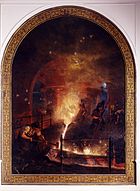Life story of a locomotive
The life story of a locomotive is a cycle of paintings by the painter Paul Meyerheim (1842–1915), which he created from 1873 to 1876 on behalf of the manufacturer Albert Borsig (1829–1878), owner of the Borsig works and, in particular, manufacturer of steam locomotives . There are six paintings, each 357 × 272 centimeters in size, and one slightly smaller, 315 × 230 centimeters in size. The six large pictures show the “metamorphosis of mineral resources into an industrial product” using the example of a Borsig locomotive, from the extraction of the ore through various stages of production to its shipping for world trade . The seventh picture, long thought to be lost, shows the Borsig family at a harvest festival on their estate in Groß Behnitz and establishes the connection between company and family history.
The monumental paintings were exhibited in a loggia , which had been built according to plans by the architect Heinrich Strack (1805-1880) from 1868 to 1870 behind the house of the Borsig family in Berlin-Moabit , and executed in oil on copper for the purpose of this open space to be weatherproof. In addition to Adolph Menzel's iron rolling mill, which was built at the same time, they are considered to be an early industrial representation in Germany, are clearly idealized and above all have a glorifying, narrative character. After the demolition of Villa Borsig at the beginning of the 20th century, the six pictures of the locomotive cycle were moved to the new Borsig Villa Reiherwerder , the seventh picture with the representation of the harvest festival was taken to the Borsig estate (shown on it) Groß Behnitz. On June 17, 2010, the six locomotive images were entered in the list of nationally valuable cultural assets. Four of them are now in the Märkisches Museum , two in the German Museum of Technology in Berlin. The seventh picture, depicting the harvest festival, came to the National Museum in Szczecin after the Second World War.
|
Extraction of the ore The painting shows ore mining in the company's own mine fields in Biskupice , Upper Silesia . Märkisches Museum |
Blast furnace tap The further production process is illustrated in this picture with iron smelting in a blast furnace , probably also in Biskupice. Märkisches Museum |
||
|
Machine factory Shown is the wheel forge in the machine hall of the Borsigwerke at the Oranienburger Tor . Märkisches Museum |
Locomotive construction This painting shows the final assembly on the locomotive, as well as the hall construction of the Borsigwerke. German Museum of Technology |
||
|
The railway bridge over the Rhine at Ehrenbreitstein This picture shows the meeting of old and new transport systems, the carriage on the road, the ship on the water and in the background the railway that crosses the Pfaffendorfer bridge between Ehrenbreitstein and Koblenz . This bridge is also a construction by the Borsig company. German Museum of Technology |
World trade Shown is the shipment of the locomotive on a quay in the port of Hamburg . Märkisches Museum |
literature
- Lili Martius: The Villa Borsig in Berlin-Moabit. About their architect Johann Heinrich Strack and the painter Paul Meyerheim. In: The Bear of Berlin. Yearbook of the Association for the History of Berlin. 1965 (Volume 14). Pp. 261-280.
- Kurt Pierson: Borsig - a name goes around the world. The history of the Borsig company and its locomotives. Berlin 1973.
- Klaus Türk: Pictures of the work. An iconographic anthology. VS Verlag, Wiesbaden 2000, ISBN 3-531-13358-6 .
- Dieter Head: Borsig. Iron foundry and mechanical engineering institute in Berlin. Berlin 1983.
- General lexicon of visual artists from antiquity to the present. founded by Ulrich Thieme and Felix Becker, Vol. 24, Leipzig 1980.
Web links
- Protection of cultural assets in Germany
- heureka-stories.de: August Borsig - His steam locomotive stopped during the race
- Photo of the seventh painting "Harvest Festival"






